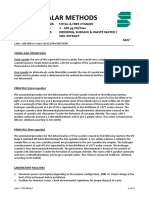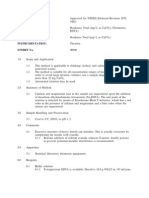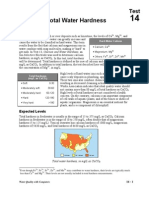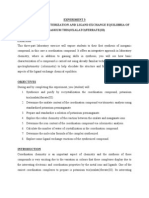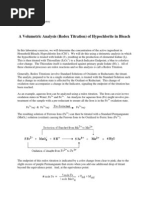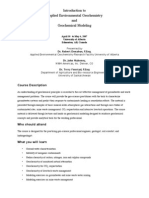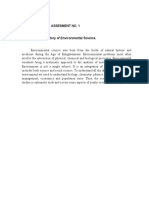0 ratings0% found this document useful (0 votes)
231 viewsEPA Method 3101
EPA Method 3101
Uploaded by
skrim240This document describes Method 310.1 for measuring alkalinity in water samples. Alkalinity is measured through titration of an unaltered water sample with a strong acid to an electrometrically determined pH of 4.5. The method is applicable to a wide range of water types and alkalinity concentrations. Sample size and normality of acid used depends on expected alkalinity concentration. Accuracy and precision data from multiple studies demonstrate the method can reliably measure alkalinity.
Copyright:
© All Rights Reserved
Available Formats
Download as PDF, TXT or read online from Scribd
EPA Method 3101
EPA Method 3101
Uploaded by
skrim2400 ratings0% found this document useful (0 votes)
231 views3 pagesThis document describes Method 310.1 for measuring alkalinity in water samples. Alkalinity is measured through titration of an unaltered water sample with a strong acid to an electrometrically determined pH of 4.5. The method is applicable to a wide range of water types and alkalinity concentrations. Sample size and normality of acid used depends on expected alkalinity concentration. Accuracy and precision data from multiple studies demonstrate the method can reliably measure alkalinity.
Original Description:
epa
Copyright
© © All Rights Reserved
Available Formats
PDF, TXT or read online from Scribd
Share this document
Did you find this document useful?
Is this content inappropriate?
This document describes Method 310.1 for measuring alkalinity in water samples. Alkalinity is measured through titration of an unaltered water sample with a strong acid to an electrometrically determined pH of 4.5. The method is applicable to a wide range of water types and alkalinity concentrations. Sample size and normality of acid used depends on expected alkalinity concentration. Accuracy and precision data from multiple studies demonstrate the method can reliably measure alkalinity.
Copyright:
© All Rights Reserved
Available Formats
Download as PDF, TXT or read online from Scribd
Download as pdf or txt
0 ratings0% found this document useful (0 votes)
231 views3 pagesEPA Method 3101
EPA Method 3101
Uploaded by
skrim240This document describes Method 310.1 for measuring alkalinity in water samples. Alkalinity is measured through titration of an unaltered water sample with a strong acid to an electrometrically determined pH of 4.5. The method is applicable to a wide range of water types and alkalinity concentrations. Sample size and normality of acid used depends on expected alkalinity concentration. Accuracy and precision data from multiple studies demonstrate the method can reliably measure alkalinity.
Copyright:
© All Rights Reserved
Available Formats
Download as PDF, TXT or read online from Scribd
Download as pdf or txt
You are on page 1of 3
METHOD #: 310.
1 Approved for NPDES (Editorial Revision 1978)
TITLE: Alkalinity (Titrimetric, pH 4.5)
ANALYTE: Alkalinity
INSTRUMENTATION: Titration
STORET No. 00410
1.0 Scope and Application
1.1 This method is applicable to drinking, surface, and saline waters, domestic and
industrial wastes.
1.2 The method is suitable for all concentration ranges of alkalinity; however,
appropriate aliquots should be used to avoid a titration volume greater than 50
mL.
1.3 Automated titrimetric analysis is equivalent.
2.0 Summary of Method
2.1 An unaltered sample is titrated to an electrometrically determined end point of
pH 4.5. The sample must not be filtered, diluted, concentrated, or altered in
any way.
3.0 Comments
3.1 The sample should be refrigerated at 4C and run as soon as practical. Do not
open sample bottle before analysis.
3.2 Substances, such as salts of weak organic and inorganic acids present in large
amounts, may cause interference in the electrometric pH measurements.
3.3 For samples having high concentrations of mineral acids, such as mine wastes
and associated receiving waters, titrate to an electrometric endpoint of pH 3.9,
using the procedure in:Annual Book of ASTM Standards, Part 31, "Water", p
115, D- 067, Method D, ( 1976).
3.4 Oil and grease, by coating the pH electrode, may also interfere, causing
sluggish response.
4.0 Apparatus
4.1 pH meter or electrically operated titrator that uses a glass electrode and can be
read to 0.05 pH units. Standardize and calibrate according to manufacturer's
instructions. If automatic temperature compensation is not provided, make
titration at 25 2 C.
4.2 Use an appropriate sized vessel to keep the air space above the solution at a
minimum. Use a rubber stopper fitted with holes for the glass electrode,
reference electrode (or combination electrode) and buret.
4.3 Magnetic stirrer, pipets, flasks and other standard laboratory equipment.
4.4 Burets, Pyrex 50, 25 and 10 mL.
5.0 Reagents
5.1 Sodium carbonate solution, approximately 0.05 N: Place 2.5 0.2 g (to nearest
mg) Na CO (dried at 250C for 4 hours and cooled in desiccator) into a 1 liter
2 3
volumetric flask and dilute to the mark.
5.2 Standard acid (sulfuric or hydrochloric), 0.1 N: Dilute 3.0 mL conc H SO or 8.3
2 4
mL conc HCl to 1 liter with distilled water. Standardize versus 40.0 mL of 0.05
N Na CO solution with about 60 mL distilled water by titrating
2 3
potentiometrically to pH of about 5. Lift electrode and rinse into beaker. Boil
solution gently for 3-5 minutes under a watch glass cover. Cool to room
temperature. Rinse cover glass into beaker. Continue titration to the pH
inflection point. Calculate normality using:
where:
A = g Na CO weighed into 1 liter
2 3
B = mL Na CO solution
2 3
C = mL acid used to inflection point
5.3 Standard acid (sulfuric or hydrochloric), 0.02 N: Dilute 200.0 mL of 0.1000 N
standardacid to 1 liter with distilled water. Standardize by potentiometric
titration of 15.0 mL 0.05N Na CO solution as above.
2 3
6.0 Procedure
6.1 Sample size
6.1.1 Use a sufficiently large volume of titrant ( > 20 mL in a 50 mL buret) to
obtain good precision while keeping volume low enough to permit
sharp end point.
6.1.2 For < 1000 mg CaCO /L use 0.02 N titrant
3
6.1.3 For > 1000 mg CaCO /L use 0.1 N titrant
3
6.1.4 A preliminary titration is helpful.
6.2 Potentiometric titration
6.2.1 Place sample in flask by pipetting with pipet tip near bottom of flask
6.2.2 Measure pH of sample
6.2.3 Add standard acid (5.2 or 5.3), being careful to stir thoroughly but
gently to allow needle to obtain equilibrium.
6.2.4 Titrate to pH 4.5. Record volume of titrant.
6.3 Potentiometric titration of low alkalinity
6.3.1 For alkalinity of <20 mg/L titrate 100-200 mL as above (6.2) using a 10
mL microburet and 0.02 N acid solution (5.3).
6.3.2 Stop titration at pH in range of 4.3-4.7, record volume and exact pH.
Very carefully add titrant to lower pH exactly 0.3 pH units and record
volume.
7.0 Calculations
7.1 Potentiometric titration to pH 4.5
where:
A = mL standard acid
N = normality standard acid
7.2 Potentiometric titration of low alkalinity:
where:
B = mL titrant to first recorded pH
C = total mL titrant to reach pH 0.3 units lower
N = normality of acid
8.0 Precision and Accuracy
8.1 Forty analysts in seventeen laboratories analyzed synthetic water samples
containing increments of bicarbonate, with the following results:
Increment as Precision as Accuracy as
Alkalinity Standard Deviation Bias, Bias,
mg/liter, CaCO mg/liter, CaCO % mg/L, CaCO
3 3 3
8 1.27 + 10.61 +0.85
9 1.14 +22.29 +2.0
113 5.28 - 8.19 -9.3
119 5.36 - 7.42 -8.8
(FWPCA Method Study 1, Mineral and Physical Analyses)
8.2 In a single laboratory (EMSL) using surface water samples at an average
concentration of 122 mg CaCO /L , the standard deviation was 3.
3
Bibliography
1. Standard Methods for the Examination of Water and Wastewater, 14th Edition, p 278,
Method 403, (1975).
2. Annual Book of ASTM Standards, Part 31, "Water", p 113, D-1067, Method B, (1976).
You might also like
- Astm Methanol SpecDocument1 pageAstm Methanol SpeclthyaguNo ratings yet
- 4.8.09 AOAC Official Method 975.08 Fluorine in Animal Feed: Distillation Method First Action 1975 Final Action 1976Document1 page4.8.09 AOAC Official Method 975.08 Fluorine in Animal Feed: Distillation Method First Action 1975 Final Action 1976Nguyễn Khang LuânNo ratings yet
- Total Free Cyanide PDFDocument11 pagesTotal Free Cyanide PDFAndres FalmacelNo ratings yet
- Astm D3590 Nitrogeno Total en Aguas PDFDocument9 pagesAstm D3590 Nitrogeno Total en Aguas PDFAlvaro Pérez PérezNo ratings yet
- Total Chloride in Alumina Supported Catalysts by Wavelength Dispersive X-Ray FluorescenceDocument5 pagesTotal Chloride in Alumina Supported Catalysts by Wavelength Dispersive X-Ray FluorescenceJesus Gonzalez GracidaNo ratings yet
- 2.4.18 Free FormaldehydeDocument2 pages2.4.18 Free FormaldehydeMulayam Singh YadavNo ratings yet
- Metoda EDTADocument5 pagesMetoda EDTACosmina PapaNo ratings yet
- 15 - Ammonical NitrogenDocument3 pages15 - Ammonical NitrogenYogesh DhekaleNo ratings yet
- Oin Ops Chem 011 Analytical Procedures For Raw MaterialDocument83 pagesOin Ops Chem 011 Analytical Procedures For Raw Materialrani100% (1)
- Ioron Determination in WaterDocument6 pagesIoron Determination in WaterGobe JamNo ratings yet
- Astm d1126 2002Document5 pagesAstm d1126 2002Marco Ccotohuanca LagunaNo ratings yet
- Skalar Methods: Analysis: Ortho Phosphate Range: 5 200 G P/liter Sample: Sea Water SANDocument6 pagesSkalar Methods: Analysis: Ortho Phosphate Range: 5 200 G P/liter Sample: Sea Water SANBruno PereiraNo ratings yet
- Astm 4377-2011 Karl FischerDocument7 pagesAstm 4377-2011 Karl FischerManuel Peña BenavidesNo ratings yet
- Preparation and Standardization of Potassium Thiocyanate Solution Lab ActDocument5 pagesPreparation and Standardization of Potassium Thiocyanate Solution Lab ActALYSSA MAE BURACNo ratings yet
- QA ChemDocument34 pagesQA ChemPrerana MitraNo ratings yet
- Chloride Ion in Water: Standard Test Methods ForDocument8 pagesChloride Ion in Water: Standard Test Methods Forsantty1617No ratings yet
- Fe by ColorimetricDocument6 pagesFe by ColorimetrickumarchemNo ratings yet
- Determination of Residual ChlorineDocument5 pagesDetermination of Residual ChlorineAjay KrishnanvNo ratings yet
- Effects of Temperature On PH v4 - TSP-01-2Document7 pagesEffects of Temperature On PH v4 - TSP-01-2Aridita AnggrainiNo ratings yet
- 09.11.2010 MethodologyDocument16 pages09.11.2010 MethodologyavvaimsvijayaNo ratings yet
- TiO2 DeterminationDocument9 pagesTiO2 Determinationdoctuer_pdh100% (1)
- 21 - Appendix II PDFDocument11 pages21 - Appendix II PDFSandeep KumarNo ratings yet
- Test 14 Total HardnessDocument7 pagesTest 14 Total HardnessshahjahanhashimaliNo ratings yet
- Aoac976 - 01 BiuretDocument1 pageAoac976 - 01 BiuretNguyen Hien Duc HienNo ratings yet
- Making Molar & Normal SolutionsDocument10 pagesMaking Molar & Normal Solutionsammuluhai333100% (2)
- Astm D2022 89 2016Document4 pagesAstm D2022 89 2016noviaaaNo ratings yet
- 18551507-079 (BS V (B) )Document3 pages18551507-079 (BS V (B) )SHOAIB NAVEED100% (1)
- Basic Lab Operations PDFDocument5 pagesBasic Lab Operations PDFErzhan OmarbekovNo ratings yet
- EuSalt AS007-2005 Potassium - Sodium Tetraphenylborate Volumetric MethodDocument5 pagesEuSalt AS007-2005 Potassium - Sodium Tetraphenylborate Volumetric MethodNguyễn Khắc HảiNo ratings yet
- TestingMethodsForFertilizers2018 PDFDocument701 pagesTestingMethodsForFertilizers2018 PDFHein Sithu AungNo ratings yet
- Department of Environmental Engineering, UET TAXILADocument5 pagesDepartment of Environmental Engineering, UET TAXILAKashif Ali JalilNo ratings yet
- Water Analysis Volume IIDocument16 pagesWater Analysis Volume IIRaphael Belano BrionesNo ratings yet
- Water Analysis Determination of Iron ProcedureDocument2 pagesWater Analysis Determination of Iron ProcedureSuresh Lakshmi NarasimhanNo ratings yet
- Water Hardness TestDocument8 pagesWater Hardness TestAbdulwali muse mohamedNo ratings yet
- Iron Determination, SpectrophotometricDocument2 pagesIron Determination, SpectrophotometricNiaz Ali KhanNo ratings yet
- AOAC 4.10.06 AOAC Official Method 2000.12 Phytase Activity in FeedDocument2 pagesAOAC 4.10.06 AOAC Official Method 2000.12 Phytase Activity in FeedAyman YounesNo ratings yet
- Astm E-1064Document4 pagesAstm E-1064Nhu SuongNo ratings yet
- Experiment 6ADocument9 pagesExperiment 6ADaniellaD21No ratings yet
- Titrimetric Determination of Sodium CarbonateDocument3 pagesTitrimetric Determination of Sodium CarbonateAbou Tebba SamNo ratings yet
- Making Molar & Normal SolutionsDocument10 pagesMaking Molar & Normal SolutionsAbhijit GadheNo ratings yet
- P HDocument8 pagesP Hmkra_natNo ratings yet
- TitrationDocument31 pagesTitrationAtul BansalNo ratings yet
- 01 - Determination of Acid ValueDocument2 pages01 - Determination of Acid ValueParixit BhandurgeNo ratings yet
- AN5391 Determination of TKN in Water by Using KT8000 SeriesDocument7 pagesAN5391 Determination of TKN in Water by Using KT8000 SeriesJaysonAbenirCabahug100% (1)
- Alkalinity Hardness &chlorideDocument34 pagesAlkalinity Hardness &chloridelhkooNo ratings yet
- Experiment 6 - EDTA Titration of The Hardness of WaterDocument2 pagesExperiment 6 - EDTA Titration of The Hardness of Waterfrogie90100% (1)
- PDF Astm d1209 - CompressDocument4 pagesPDF Astm d1209 - CompressAbd-Elrahman E. OmarNo ratings yet
- Determination of Hardness of Water (Step-By-Step Plan)Document6 pagesDetermination of Hardness of Water (Step-By-Step Plan)ravenheart90No ratings yet
- TritationDocument9 pagesTritationapi-299017686100% (1)
- Determination of Glucose by Titration With Fehling's ReagentDocument5 pagesDetermination of Glucose by Titration With Fehling's ReagentMohamed Abdelghni EmaraNo ratings yet
- Bod Cell TestDocument1 pageBod Cell TestΠΟΠΗNo ratings yet
- Determination of Chlorine Content in NaOClDocument9 pagesDetermination of Chlorine Content in NaOClSihanu SubasinghaNo ratings yet
- Aoac 973 - 41 (2019 - 07 - 17 07 - 17 - 12 Utc)Document1 pageAoac 973 - 41 (2019 - 07 - 17 07 - 17 - 12 Utc)pavanNo ratings yet
- Analysis Method For Starch: Japan Customs Analysis MethodsDocument3 pagesAnalysis Method For Starch: Japan Customs Analysis Methodsrusli308No ratings yet
- CHEM 334 Quantitative Analysis Laboratory: Calibration of Volumetric GlasswareDocument6 pagesCHEM 334 Quantitative Analysis Laboratory: Calibration of Volumetric Glasswareasjad rajaNo ratings yet
- Bromato 48-42Document3 pagesBromato 48-42Sarah WellsNo ratings yet
- MT ElectrodsDocument28 pagesMT ElectrodsLuisa'fer SaavedraNo ratings yet
- Titration Techniques For Volumetric Analysis TutorialDocument13 pagesTitration Techniques For Volumetric Analysis TutorialLydia LamNo ratings yet
- EPA Method 3101 PDFDocument3 pagesEPA Method 3101 PDFJalpit MardenNo ratings yet
- No 3Document12 pagesNo 3Punit Ratna ShakyaNo ratings yet
- Semester I: Course Timetable - CHEM 2470, Introduction To Analytical ChemistryDocument3 pagesSemester I: Course Timetable - CHEM 2470, Introduction To Analytical Chemistryskrim240No ratings yet
- R 3528Document3 pagesR 3528skrim240No ratings yet
- Writing The Conclusion To Your Literature Review: See Example BelowDocument1 pageWriting The Conclusion To Your Literature Review: See Example Belowskrim240No ratings yet
- Semester I: Room Timetable - FFA DAEE Computer LabDocument1 pageSemester I: Room Timetable - FFA DAEE Computer Labskrim240No ratings yet
- Semester I: Room Timetable - FST CSL1Document2 pagesSemester I: Room Timetable - FST CSL1skrim240No ratings yet
- Chemical Examples For The Fit Equations: ExampleDocument11 pagesChemical Examples For The Fit Equations: Exampleskrim240No ratings yet
- K A Ó B K: Kinetics of Multiple ReactionsDocument5 pagesK A Ó B K: Kinetics of Multiple Reactionsskrim240No ratings yet
- Summer: Course Timetable - CHEM 2015, SpectrosDocument1 pageSummer: Course Timetable - CHEM 2015, Spectrosskrim240No ratings yet
- Summer: Course Timetable - CHEM 2260, Basic Organic Chemistry IDocument1 pageSummer: Course Timetable - CHEM 2260, Basic Organic Chemistry Iskrim240No ratings yet
- Summer: Course Timetable - CHEM 2360, Basic Physical ChemistryDocument1 pageSummer: Course Timetable - CHEM 2360, Basic Physical Chemistryskrim240No ratings yet
- Experiment 3 Synthesis, Characterization and Ligand Exchange Equilibria of Potassium Tris (Oxalato) Ferrate (Iii)Document7 pagesExperiment 3 Synthesis, Characterization and Ligand Exchange Equilibria of Potassium Tris (Oxalato) Ferrate (Iii)skrim240100% (1)
- ZincEDTA PDFDocument22 pagesZincEDTA PDFskrim240No ratings yet
- Lecture 9 Introductory Kinetics PDFDocument78 pagesLecture 9 Introductory Kinetics PDFskrim240No ratings yet
- Kinetics Solution PDFDocument15 pagesKinetics Solution PDFskrim240No ratings yet
- Beers LawDocument5 pagesBeers Lawskrim240No ratings yet
- LABILEDocument5 pagesLABILEskrim240No ratings yet
- A Volumetric Analysis (Redox Titration) of Hypochlorite in BleachDocument5 pagesA Volumetric Analysis (Redox Titration) of Hypochlorite in Bleachskrim240No ratings yet
- Civ V BNW PC Online Manual EngDocument17 pagesCiv V BNW PC Online Manual Engskrim240No ratings yet
- Chlorine Thiosulfate TitrationDocument3 pagesChlorine Thiosulfate Titrationskrim240No ratings yet
- STEM - General Biology 1 CG - 1Document4 pagesSTEM - General Biology 1 CG - 1Anonymous TsEj4WZ58% (12)
- Material Safety Data Sheet: (JIS Z 7250:2005)Document6 pagesMaterial Safety Data Sheet: (JIS Z 7250:2005)qualidade promasqNo ratings yet
- Introduction To Applied Environmental Geochemistry and Geochemical ModelingDocument5 pagesIntroduction To Applied Environmental Geochemistry and Geochemical ModelingПростой ЧеловекNo ratings yet
- Purification of Water by Solar Energy: Department of Renewable Energy, University College of Engineering, KotaDocument7 pagesPurification of Water by Solar Energy: Department of Renewable Energy, University College of Engineering, Kotayatharth sharmaNo ratings yet
- Titanium Phase DiagramDocument97 pagesTitanium Phase DiagramLuis AliagaNo ratings yet
- Stepan Formulation 1125Document2 pagesStepan Formulation 1125ricardo navarreteNo ratings yet
- MasterSeal 7000 CR Chemical Resistance Guide - Rebranded Version 2021Document6 pagesMasterSeal 7000 CR Chemical Resistance Guide - Rebranded Version 2021fredo estradaNo ratings yet
- Understanding Coating Weight Designations For Zinc-Based Coatings On Steel SheetDocument11 pagesUnderstanding Coating Weight Designations For Zinc-Based Coatings On Steel SheetOlgalycosNo ratings yet
- Review of LiteratureDocument9 pagesReview of Literatureworlds tourNo ratings yet
- E 353 - 93 R00 - RTM1MW - PDFDocument33 pagesE 353 - 93 R00 - RTM1MW - PDFDavid AriasNo ratings yet
- MS 01 180Document88 pagesMS 01 180DucVikingNo ratings yet
- Ionic BondDocument6 pagesIonic BondAhmed NasrNo ratings yet
- Chemistry Test # 2 (R6) 07-12-13Document1 pageChemistry Test # 2 (R6) 07-12-13Qaisar RiazNo ratings yet
- CFD Simulation of Boiling Flows Using The Volume-Of-Fluid Method Within OpenFOAM Sir PaperDocument17 pagesCFD Simulation of Boiling Flows Using The Volume-Of-Fluid Method Within OpenFOAM Sir PaperedNo ratings yet
- Estimating Ethylene Glycol Injection Rate For Hydrate InhibitionDocument2 pagesEstimating Ethylene Glycol Injection Rate For Hydrate InhibitionKeila ChavesNo ratings yet
- Petamo Ghy 133 N: Product InformationDocument4 pagesPetamo Ghy 133 N: Product Informationphucdc095041No ratings yet
- Jurnal of CatalysDocument28 pagesJurnal of CatalysBagus okaNo ratings yet
- MatterDocument56 pagesMatterReyna Myra EstradaNo ratings yet
- I .Polyethylene Duct and ConduitDocument42 pagesI .Polyethylene Duct and ConduitMuhammed Siddik100% (1)
- Horizontal Tube EvaporatorDocument16 pagesHorizontal Tube EvaporatorFarzana IslamNo ratings yet
- Carbohydrate Complete Notes (B.pharm 2nd Sem)Document25 pagesCarbohydrate Complete Notes (B.pharm 2nd Sem)DIPENDRA KUMAR KUSHAWAHANo ratings yet
- Course Outcomes Assesment No. 1 1. Discuss The History of Environmental ScienceDocument4 pagesCourse Outcomes Assesment No. 1 1. Discuss The History of Environmental ScienceNefer PitouNo ratings yet
- Format Presentation Day 1 - ADxDocument131 pagesFormat Presentation Day 1 - ADxTou NechNo ratings yet
- Metco - Thermal Spray Powders (Nickel Chromium Alloy Boron Nitride)Document3 pagesMetco - Thermal Spray Powders (Nickel Chromium Alloy Boron Nitride)Hamed AhadiNo ratings yet
- Laboratory Exercise #2 - The Chemical Basis of LifeDocument4 pagesLaboratory Exercise #2 - The Chemical Basis of LifeRee YanaNo ratings yet
- International Society of Automation, (ISA), Standard, Materials, Human Engineering, and Control RoomDocument8 pagesInternational Society of Automation, (ISA), Standard, Materials, Human Engineering, and Control RoomGiovanniNo ratings yet
- N° de Série/ .: Sur Le ThèmeDocument145 pagesN° de Série/ .: Sur Le Thèmebidounou essianeNo ratings yet
- Inner and Outer Pipe of PE-Xc, Quality AssuredDocument2 pagesInner and Outer Pipe of PE-Xc, Quality AssuredAnonymous O0T8aZZNo ratings yet
- Enduro 600 (Macrosythetic Fiber)Document0 pagesEnduro 600 (Macrosythetic Fiber)Sunilgiri001No ratings yet
- A Comparative Analysis of The Performance of Various Equations of State in Thermodynamic Property Prediction of Reservoir Fluid SystemsDocument12 pagesA Comparative Analysis of The Performance of Various Equations of State in Thermodynamic Property Prediction of Reservoir Fluid SystemsFaith BabalolaNo ratings yet


